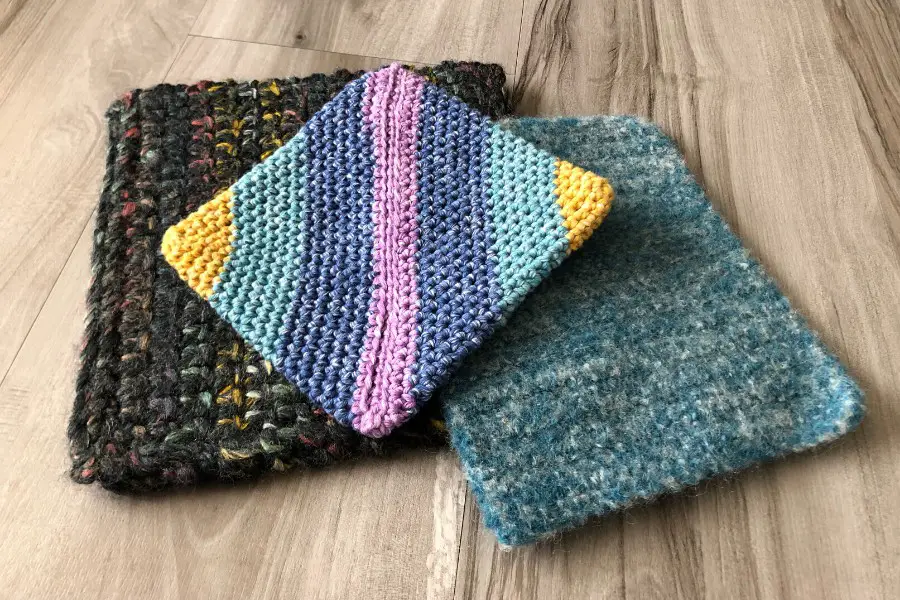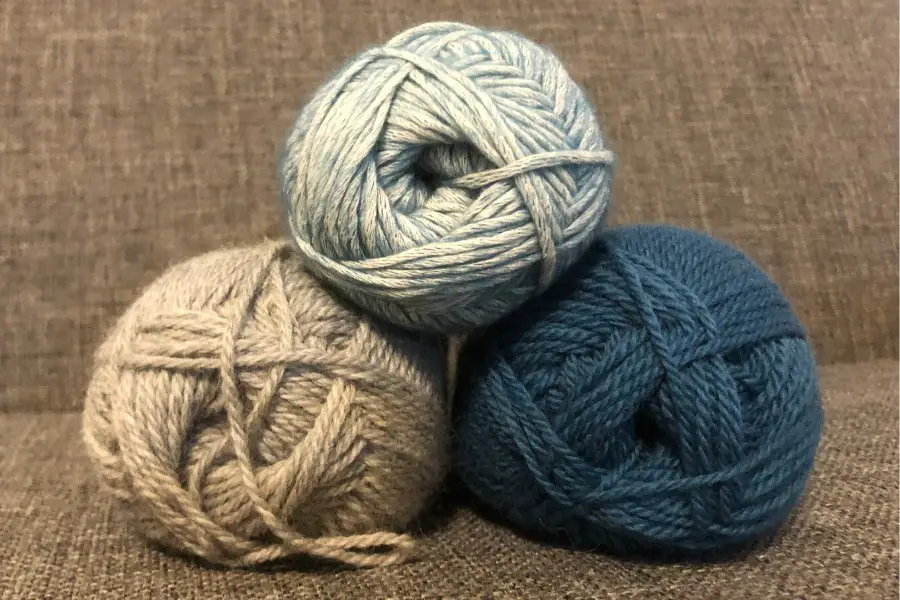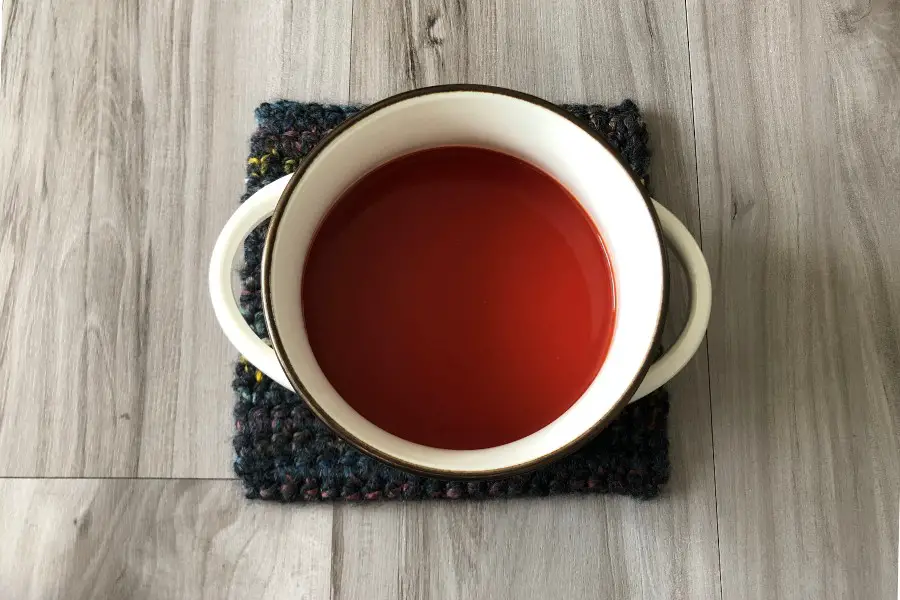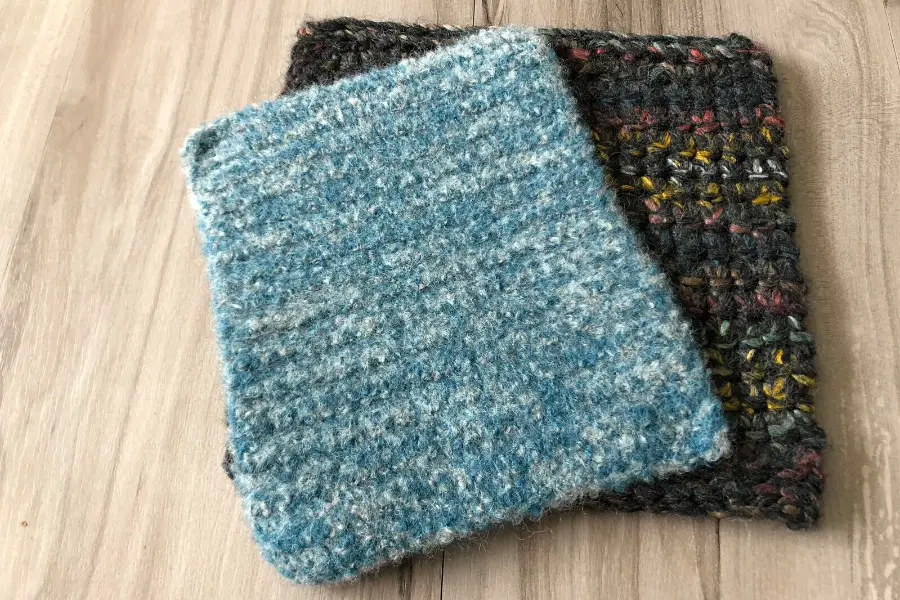
Pot holders are a kitchen essential. Even if the only cooking you do comes from the microwave. They are simple to make with yarn and a pair of knitting needles or a crochet hook. And pot holders are fun because they are easily customizable for any kitchen.
Not too long ago I burned my finger getting a hot pan out of the oven. I did use pot holders, but honestly, they should have been thrown away awhile ago. Instead of replacing them with cheap store bought pot holders, I decided to make my own, which inspired this post.
There are many yarn choices out there, but how do you choose? Natural fibers provide the best type of yarn for knit or crochet pot holders. More specifically, cotton or wool. They are top choices because they can withstand heat and will prevent hot cookware from burning you. The whole point of a pot holder!
Synthetic fibers, on the other hand, can melt in high temperatures and they don’t insulate well. However, that does not mean they can’t be used.
The yarn is important because it can make or break the simple function of a pot holder. I’ve done the research and tested different yarns and came up with the top 8 qualities that you should look for in a yarn if you want to make crochet or knit pot holders. Please follow along and find my yarn suggestions and knit and crochet patterns for pot holders at the end.
1. Choose a Yarn That is Non-Flammable.
The whole point of a pot holder is to touch items with hot temperatures so that your hand does not burn. It would be counterintuitive to have your pot holder burst into flames while in use. A reason yarn choice is so important.
Natural fibers are the best kind to use for pot holders because they have a high burning point and will not melt, unlike synthetic fibers. According to Learn About Wool, a free classroom resource that teaches about the production and processing of wool in Australia, wool has the highest ignition point at 600°C (over 1100°F), and cotton will burn if introduced to a flame at 210°C (about 410°F).
Cotton and wool are the best choices for pot holders because they won’t burn easily. They are also readily available at any chain craft store at affordable prices for this type of project. However, if you choose wool, do NOT use superwash wool for pot holders. The fibers are treated with chemicals that could make the yarn flammable.
There are other natural fibers out there that can withstand hot temperatures without burning. However, these yarn choices are not always economical. Silk won’t burn easily if used in a pot holder, but would you really want to use a luxury yarn for something that will inevitably get dirty? Also linen could be used too, but it’s thinner than cotton or wool and would require more yardage. The choice is up to you though!
Now, what about synthetic fibers? Unlike their natural counterparts, synthetic fibers do not burn. They melt. This makes synthetic yarns more dangerous for a project like pot holders because they will have to interact with heat.
Polyester melts at 252 – 292°C (487 – 558°F) and nylon will melt at a lower temperature between 160 – 260 °C (320 – 500°F). Therefore, you can expect acrylic yarn to melt at high temperatures too. One source says it melts at 160°C/320°F. This scares most people, so nearly every source online will recommend you to never use acrylic yarn (or other synthetic fiber) for pot holders. But does that mean you can’t use acrylic yarn? No.
INSIDER TIP: If you know you will be cooking over an open flame, use wool yarn to make pot holders. Wool by nature is self-extinguishing and has to be exposed to super high temperatures to burn.

2. Choose a Yarn that can Hold up to Hot Temperatures.
As discussed in the previous section, you want your pot holder to withstand the heat from the pan or lid you handle. You don’t want it to melt when it comes into contact with a hot surface. We already know wool and cotton can hold up to hot temperatures. Many other knitters and crocheters would agree with me that these make the best pot holders.
I checked many blog posts and forums on the topic of what yarn is best for pot holders. I would say every single page recommended cotton as #1 and wool as a close second. And nearly every article or answer to the question said acrylic should not be used ever because it will melt.
3. Choose an Absorbent Yarn.
Pot holders will inevitably get things spilled on them at some point. This can happen when transferring a pot to the table or taking a lid off the pan, etc. So it is useful for the material of the pot holder to be absorbent.
Cotton is an absorbent material. When a spill is made onto a pot holder made from cotton, it is convenient to only have a mess on the pot holder. The surface will require little clean up and the pot holder can be thrown into the wash. Zero to little mess. Also, depending on the thickness, if the liquid spilled is hot, the absorbent pot holder can shield your hand or surface from the heat.
Acrylic yarns do absorb water and other liquids, but not to the same extent as cotton. Cotton immediately absorbs liquids until it has retained its capacity. Acrylic will get wet, but if there are gaps in the stitches, liquids will seap through onto the surface beneath it. A mess will be left behind.
Wool is a naturally water repellant material. A pot holder made from wool will not soak up liquid spills in the same way as cotton. You are likely to have more of a mess to clean up since wool cannot soak up the liquid. And you will undoubtedly have less protection from the hot liquid if it is spilled onto your body or countertop.

4. Choose a Yarn that is Inelastic When Wet.
The yarn used to make knit or crochet pot holders should hold its shape, especially when wet. Since pot holders come into contact with food and liquids, it is useful for them to absorb the liquid, but you don’t want it getting stretched out of shape.
Pot holders will also need to be washed occasionally. The fibers will need to be able to handle water without becoming disfigured. A stretched out fabric will result in less protection from heat, which we don’t want. Not to mention, the appearance would be messed up.
Cotton is a material that is very absorbent and is inelastic when wet. But other materials, such as wool, can stretch out when wet, so you must be careful handling them in that condition.
Pot holders are easy projects to whip out, but you don’t want your hard work going to waste. Take care to find a yarn that is inelastic when it becomes wet.
5. Choose an Easy to Clean Yarn.
Potholders are constantly used around food. But you never know when something might get spilled onto it. So it is in your best interest to choose a yarn that is easy to clean.
The easiest way to clean a potholder is to throw it into the washing machine with your other towels. Then you can dry it and you have a clean potholder. Or hand washing is an option too. It just takes more time because it must also air dry.
As I mentioned previously, cotton and wool are the most common yarns to use for potholders. When it comes to washing, cotton is the easier material to wash. Cotton potholders can be thrown into the washing machine and dryer with other towels and things without altering the shape. The cotton potholder will come out good as new.
In contrast, wool needs to be hand washed. It is a sensitive material when wet and must be handled carefully so that it doesn’t stretch out. You would need a wool wash to properly clean it. And the potholder should dry on a flat surface.
6. Choose a Yarn that Insulates and Does not Transfer Heat.
How does this differ from the first two sections? Well, as we have already estsablished, potholders are mainly used to shield your hand or a surface from the heat. And we already know there are materials that can withstand hot temperatures and won’t burn. But, another important aspect of the yarn used to make the material is that it needs to have insulation.
Just because a material can withstand high temperatures does not mean you should use it to make potholders. Insulation is important because it will hold in the heat and not transfer it to your hand. All you will feel is warmth of what you are holding on your hands.
Cotton and wool are great insulators and will keep the heat from burning you. Other materials have less insulation, but with thicker stitches or a couple layers, they could provide enough insulation.

7. Select a Worsted Weight Yarn or Thicker.
This section is important for making your own crochet or knit potholders. There are a couple of things to cover: yarn weight and stitch patterns.
Yarn weight is one of the first things to consider before getting started on your project. The yarn needs to be thick enough to insulate the heat and keep your hands and surfaces safe. A worsted weight yarn (#4) or thicker will do. However, this is just a guideline. There are a couple things you can do if you want to use a thinner yarn or want the potholder to be thicker overall.
- Take two strands of yarn and knit or crochet normally. Doubling the strands will make a bigger and thicker stitch. This is helpful if the yarn weight you chose is too thin crocheted or knit by itself.
- Crochet or knit two pieces of fabric and seam together. Some don’t like the bulkiness of using two strands at once, but this option makes a thick potholder as well.
Patterns are also going to contribute to the thickness and sturdiness of the potholder. You want big stitches with little to no gaps between them. Patterns such as lace are not ideal for this type of project. Lace is pretty, but there are too many gaps for your hand to get burned.
For pattern suggestions, please read to the end. I found a few video tutorials for knit and crochet potholders that I think you’ll want to see!
INSIDER TIP: If you choose to use wool, you should felt the potholder to make a thicker fabric. For a quick and easy tutorial, check out this video on YouTube that shows you how to felt wool.
I crocheted the blue and gray potholder holding two strands of Patons wool (found at Joann) yarn together. Then I felted it based on the instructions in the video I linked to previously. The potholder is very thick, no heat gets through, and the marled look is an added bonus. 100% recommend this!

8. Choose a Darker Color of Yarn.
The color choice is ultimately up to you. Make it match the colors of your kitchen, choose a bright color to stand out, or choose your favorite color. It doesn’t matter.
If you just can’t decide on a color, keep in mind that if you choose a dark color, stains will not show as prominently. Accidents will happen and the potholder will eventually get dirty. Unfortunately, some spots will only fade, not disappear. Which is why a dark color comes in handy.
At the store, they have some black yarns with a splash of color, similar to what is pictured above. I like this because I still have color, but stains will not show.
Great Yarn Options for Potholders
All of these yarn options I found in stores at my local Joann, Michael’s and Hobby Lobby. They are all affordable (wool is a little pricey…) and readily available. So grab a skein or two from your local craft store and check out the patterns I have listed in the next section for you to try out!
- Lion Brand Re-Up: Cotton
- Lily Sugar’n Cream: Cotton
- Loops and Threads Cotton Colors: Cotton
- Patons Classic Wool: Wool
- *Note: Michaels has it cheaper at regular price ($5.99) than Joann ($7.99) but they are the same exact thing. Pay attention to coupons though! I got mine with a 60% coupon at Joann.
- DIY your own t-shirt yarn: Cotton
Crochet and Knit Potholder Patterns
I am a very visual person. So I found a few YouTube tutorials and blog posts that go into detail on how to knit or crochet your very own potholders.
Try out these thick knit potholders. The tutorials are so easy to follow!
This looks like a really thick potholder, and the crochet detailing adds a little flare. Knitting with two colors is a little more advanced, but she shows you exactly how to do it, so there is no doubt you can accomplish this!
If you have old t-shirts lying around and you don’t know what to do with them, make them into yarn! And when you do, you can make this cute potholder with the simple tutorial below.
And if you would prefer to crochet or want a super simple beginner project, be sure to try these crochet potholders out!
The double thick cotton potholders are one of my favorites. This was the first potholder I decided to try out for myself. I had a lot of fun with it and the pattern is so simple. If you want written instructions, I found these online, otherwise, just watch the following video. That’s what I did and I love the results!
There is a crochet stitch called the thermal stitch. It is super thick and perfect for potholders. Ashleigh, from Sewrella, created a potholder pattern using that stitch. The pattern is perfect if you want don’t want to seam at the end or crochet in the round. Check out her video tutorial below, and if you want written instructions, head over to her blog and find it here.
